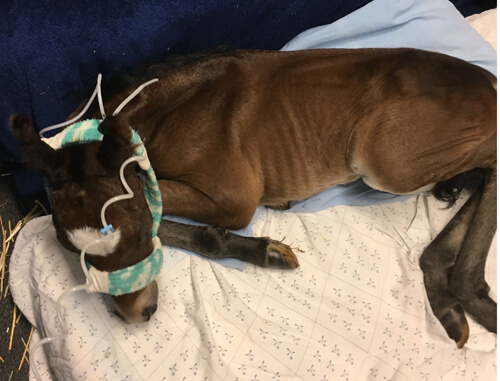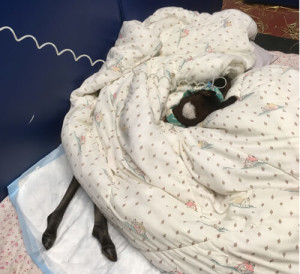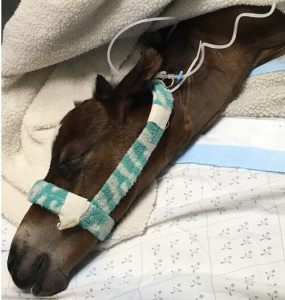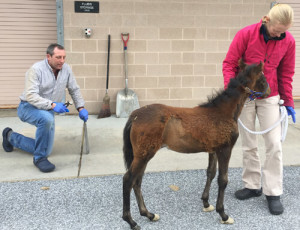Feisty Filly: The Story of the Premie “Tamara Rose”
“You need to get to the barn immediately.” These words jolted Beaverlea Roye-Manderbach, as she took an early-morning call in mid-October from one of her employees at Laota Spring Farm in Sinking Hill, PA. One of her prize Paso Fino mares, Chaperona, had just given birth to a filly – six weeks early, and the filly was not moving.
“There was a little baby lying there,” described Manderbach, “Mom was standing over her.” Trained as a physician, Manderbach took the filly’s vitals and made sure the airway was open, then she and her foreman immediately loaded the mare in the trailer, the filly in the back seat with a pad, warm bottles, and blankets, and rushed to New Bolton Center.
“By the time we got there, the baby was making noise and trying to suckle,” said Roye-Manderbach, a positive sign. “I made the decision right then to try and save her,” said Roye-Manderbach.
When New Bolton Center emergency and internal medicine clinician Dr. Michelle Linton first met the little filly, she was in dire straits. She was only a few hours old, more than a month premature and, at 29 pounds, at least 60 pounds underweight. Her vital signs were critical and her body temperature was 10 degrees below normal. She couldn’t stand because she was too weak and underdeveloped.
Linton, who specializes in neonates, knew they were facing a difficult set of challenges, but everyone was determined to give her a fighting chance.
The preemie, named Tamara Rose after New Bolton Center reproduction specialist Dr. Tamara Dobbie, was admitted to the hospital on October 17, 2016. She was was in critical condition.
“While she had periods of activity when she could hold her head up and show us a weak suckle, she was mostly somnolent,” said Linton, who dedicated herself to Tamara Rose’s care.
The first two weeks of Tamara Rose’s life were a roller coaster of medical problems and worries. “She had little blood flow circulating to her periphery, so her legs, ears, and muzzle were ice cold. Her immediate medical problems were numerous and included septicemia and septic shock, prematurity leading to small body size and incomplete ossification of cuboidal bones, kidney and gastrointestinal dysfunction, as well as neurologic disease.”
When Tamara Rose was two days old, she began to have lengthy seizures. When she wasn’t having seizures, she slipped into a coma-like state. “This is a very typical course for our sick neonatal foals,” said Linton. Intensive nursing care was provided to ensure she stayed clean, dry and placed in alternating recumbency in order to support her lung function. “We watched her urine production closely and used an ultrasound to monitor the volume of urine in her bladder,” said Linton. Urinary catheters were used to empty her bladder when she wasn’t able to urinate.
Tamara Rose was maintained on intravenous nutrition and fluids because of the high likelihood of gastrointestinal problems. She developed a systemic infection, which was treated with intravenous antibiotics. Skin ulcers formed from her infection and her inability to stand.
The Effort of Survival
Each of Tamara Rose’s problems was complex, and required immediate and intensive care. High doses of intravenous fluids were initiated. She was given intravenous fluids and medications to help regulate blood flow and to maintain her blood pressure. Because she was unable to take on colostrum or milk, nutrition was provided by an intravenous line and an insulin infusion was given to help her manage her nutrition. She was on seven fluid and mediation infusion pumps when she was at her most critical.
Part of the course of treatment was to keep Tamara Rose in a confined area in the dark to let her sleep and grow. Her environment was kept quiet to minimize stimulation and triggers for her seizures.
With the help of medications and supportive care, the seizures stopped. Medical-grade honey-infused patches helped to heal her wounds, and the tiny foal began to improve.
At just over 30 pounds, Tamara Rose was only allowed to stand with assistance, and for brief periods. Tamara Rose had incomplete ossification of her carpal and tarsal bones. “In other words, some bones in her joints were still cartilage and had not yet converted to bone,” said Linton. “If too much pressure is placed on these joints, they will crush and lead to permanent deformation of bone and high risk for degenerative joint disease early in life.”
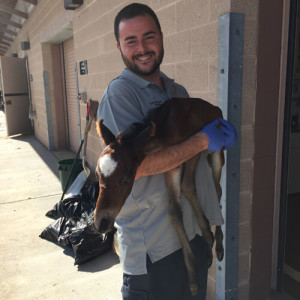 Months One & Two: Gaining Strength
Months One & Two: Gaining Strength
It Takes a Team
Once Tamara Rose had become medically stable, Linton developed a feeding and strengthening program, enlisting the highly skilled veterinary nursing team and other New Bolton clinical experts, including equine surgeon Dr. Kyla Ortved and farrier Pat Reilly.
During the first month, in addition to aggressive nutritional goals, the team addressed Tamara Rose’s legs and her lack of bone. “She could stand, but we couldn’t let her bear weight for long, since that would run the risk of cuboidal bone crush injury,” said Linton. “We were always assessing the fine line between doing too much or not enough.”
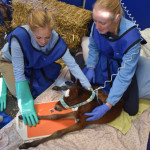 Diagnostic Imaging: Here, Tamara Rose is undergoing some diagnostic imaging to assess the level of bone growth. This was a key diagnostic tool to determine the kind of activity and its duration to benefit the little filly’s development.
Diagnostic Imaging: Here, Tamara Rose is undergoing some diagnostic imaging to assess the level of bone growth. This was a key diagnostic tool to determine the kind of activity and its duration to benefit the little filly’s development.
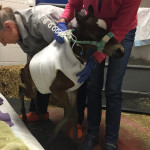 Careful Motion: Since the clinical team needed to move Tamara Rose periodically for various reasons, they developed a special sling to lift and lower her as carefully as possible.
Careful Motion: Since the clinical team needed to move Tamara Rose periodically for various reasons, they developed a special sling to lift and lower her as carefully as possible.
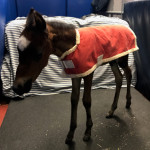 Staying Warm: Since winter was in full swing, it was critical to keep Tamara Rose warm. Since she continued to gain weight, she transitioned through several styles and sizes of horse blankets made to specification.
Staying Warm: Since winter was in full swing, it was critical to keep Tamara Rose warm. Since she continued to gain weight, she transitioned through several styles and sizes of horse blankets made to specification.
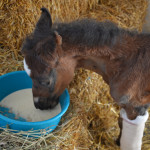 Developing an appetite: Now just over 30 pounds, Tamara Rose, who had to be taught to stand, began to wobble around her stall. When the nursing staff warmed her milk, the filly would cry out when she heard the beep of the microwave. To help her transition to milk pellets, the team added pellets to her milk feedings which encouraged Tamara Rose to start investigating eating solid food.
Developing an appetite: Now just over 30 pounds, Tamara Rose, who had to be taught to stand, began to wobble around her stall. When the nursing staff warmed her milk, the filly would cry out when she heard the beep of the microwave. To help her transition to milk pellets, the team added pellets to her milk feedings which encouraged Tamara Rose to start investigating eating solid food.
Developing strength: While Tamara began to gain strength, it was important to make sure her legs were developing properly. Her care team created a special splint to provide an external support structure. However, it was important not to let the filly become dependent on the splint. Constant oversight and judgements needed to be made as to how long the splint should stay on.
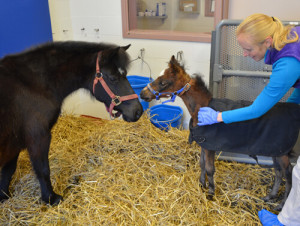 Month Three: Tamara Rose Meets Daisy, Companion Horse
Month Three: Tamara Rose Meets Daisy, Companion Horse
A couple of months into her treatment, Tamara Rose had gained both weight and strength, and it was time to introduce a companion horse. Roye-Manderbach brought one of the farm’s ponies, Daisy, to live with Tamara Rose so that the little filly would gain more exposure to horses.
“There is only so much that we can do to teach Tamara Rose how to behave like a horse,” said Linton. “The best way for her to learn the ‘do’s and don’ts’ of being a horse is from one of her own.” The goal was for Tamara Rose to bond with Daisy so she would continue to spend time in the pasture with her upon returning to Laota Spring Farm.
At first, Tamara Rose wasn’t quite sure what to make of this new animal, but they quickly began to bond, and soon started accompanying each other on their daily walks. Daisy even introduced Tamara Rose to the magic of eating grass.
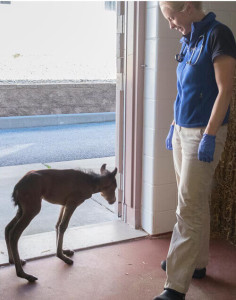 Introducing Shoes: Straightening Legs & Strengthening Muscle
Introducing Shoes: Straightening Legs & Strengthening Muscle
While Tamara Rose could now walk, and she was definitely gaining weight, the splint wasn’t a long-term solution because it would just cause her to rely on an external support, rather than properly developing her own musculature. Linton and Ortved decided it would be best for farrier Pat Reilly to create special heel extensions that would re-enforce Tamara Rose’s legs to use the right muscles when she walked.
In addition to her incomplete ossification, Tamara Rose had severe laxity in her legs. The soft-tissue structures in her legs were very loose, causing her carpi to lose stability and bend in the wrong direction. Her fetlocks were dropped to the ground and she walked on her heels and the back of her pasterns, rather than on the soles of her hooves.
“Initially we trimmed her feet,” said Linton, “but that only improved her legs minimally.” The next step was to apply heel extensions which extend a few centimeters beyond the heel bulbs and encourage the foot’s weight-bearing surface to better distribute to the sole of the hoof.
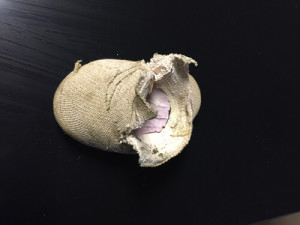 Heel Extensions: Over the next several weeks, Reilly, Linton, and Ortved closely monitored the effectiveness of the specially designed heel extensions. Tamara Rose required daily assessment and frequent changes to the heel extensions to accommodate for changes as they occurred. “It can be easy to create more problems if you don’t keep up with any changes,” said Reilly.
Heel Extensions: Over the next several weeks, Reilly, Linton, and Ortved closely monitored the effectiveness of the specially designed heel extensions. Tamara Rose required daily assessment and frequent changes to the heel extensions to accommodate for changes as they occurred. “It can be easy to create more problems if you don’t keep up with any changes,” said Reilly.
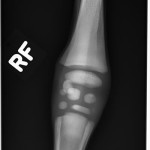
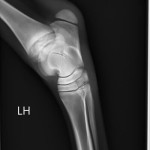
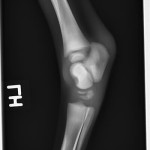
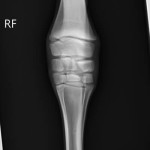 Exercise: the Key to Strength- From that point on, Tamara Rose was put on a controlled exercise program. In order to strengthen her legs, she required just the right amount of exercise each day. Linton accompanied Tamara Rose on daily walks around New Bolton Center, exploring new areas and surfaces.
Exercise: the Key to Strength- From that point on, Tamara Rose was put on a controlled exercise program. In order to strengthen her legs, she required just the right amount of exercise each day. Linton accompanied Tamara Rose on daily walks around New Bolton Center, exploring new areas and surfaces.
Finally, the moment arrived. Linton, Ortved, and Reilly agreed. Tamara Rose was ready to stand on her own. “Her last shoe change was on February 24 and we were able to remove her shoes extensions completely,” said Linton.
Going Home
From her original weight of 29 pounds, Tamara Rose continued to grow and strengthen. Today, at 155 pounds, she weighs more than five times what she weighed on admission to the hospital. “I expect her to be able to return to the farm soon,” said Dr. Linton. In mid-March, Tamara Rose and Daisy will return to Laota Spring Farm, and the little filly with a tough start will finally begin to experience the life of a regular horse.










